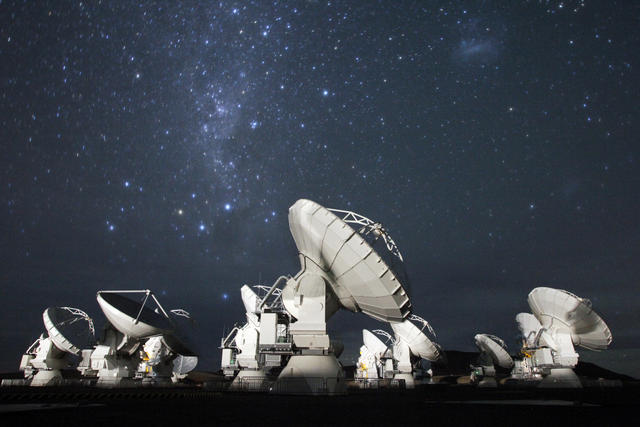
The ALMA Observatory antennas. Photo: ALMA
WASHINGTON (PTI): Astronomers have discovered large quantities of organic molecules at the centre of the Milky Way that resemble life-bearing amino acids in their complexity.
Hunting from a distance of 27,000 light years, astronomers discovered an unusual carbon-based molecule - one with a branched structure - contained within a giant gas cloud in interstellar space.
Like finding a molecular needle in a cosmic haystack, astronomers have detected radio waves emitted by isopropyl cyanide. The discovery suggests that the complex molecules needed for life may have their origins in interstellar space.
Using the Atacama Large Millimetre/submillimetre Array, known as the ALMA Observatory, Astronomers from Cornell University, the Max Planck Institute for Radio Astronomy and the University of Cologne (Germany) studied the gaseous star-forming region Sagittarius B2.
Organic molecules usually found in these star-forming regions consist of a single "backbone" of carbon atoms arranged in a straight chain.
But the carbon structure of isopropyl cyanide branches off, making it the first interstellar detection of such a molecule, said Rob Garrod, Cornell senior research associate at the Centre for Radiophysics and Space Research.
This detection opens a new frontier in the complexity of molecules that can be formed in interstellar space and that might ultimately find their way to the surfaces of planets, said Garrod.
The branched carbon structure of isopropyl cyanide is a common feature in molecules that are needed for life - such as amino acids, which are the building blocks of proteins.
This new discovery lends weight to the idea that biologically crucial molecules, like amino acids that are commonly found in meteorites, are produced early in the process of star formation - even before planets such as Earth are formed.
Researchers sought to examine the chemical makeup of Sagittarius B2, a region close to the Milky Way's galactic centre and an area rich in complex interstellar organic molecules.
The group conducted a full spectral survey - looking for fingerprints of new interstellar molecules - with sensitivity and resolution 10 times greater than previous surveys.
"Understanding the production of organic material at the early stages of star formation is critical to piecing together the gradual progression from simple molecules to potentially life-bearing chemistry," said lead author Arnaud Belloche.
About 50 individual features for isopropyl cyanide (and 120 for normal-propyl cyanide, its straight-chain sister molecule) were identified in the ALMA spectrum of the Sagittarius B2 region, researchers said.
The two molecules - isopropyl cyanide and normal-propyl cyanide - are also the largest molecules yet detected in any star-forming region.
The research was published in the journal Science.
 Previous Article
Previous Article Next Article
Next Article












The Indian Air Force, in its flight trials evaluation report submitted before the Defence Ministry l..
view articleAn insight into the Medium Multi-Role Combat Aircraft competition...
view articleSky enthusiasts can now spot the International Space Station (ISS) commanded by Indian-American astr..
view article